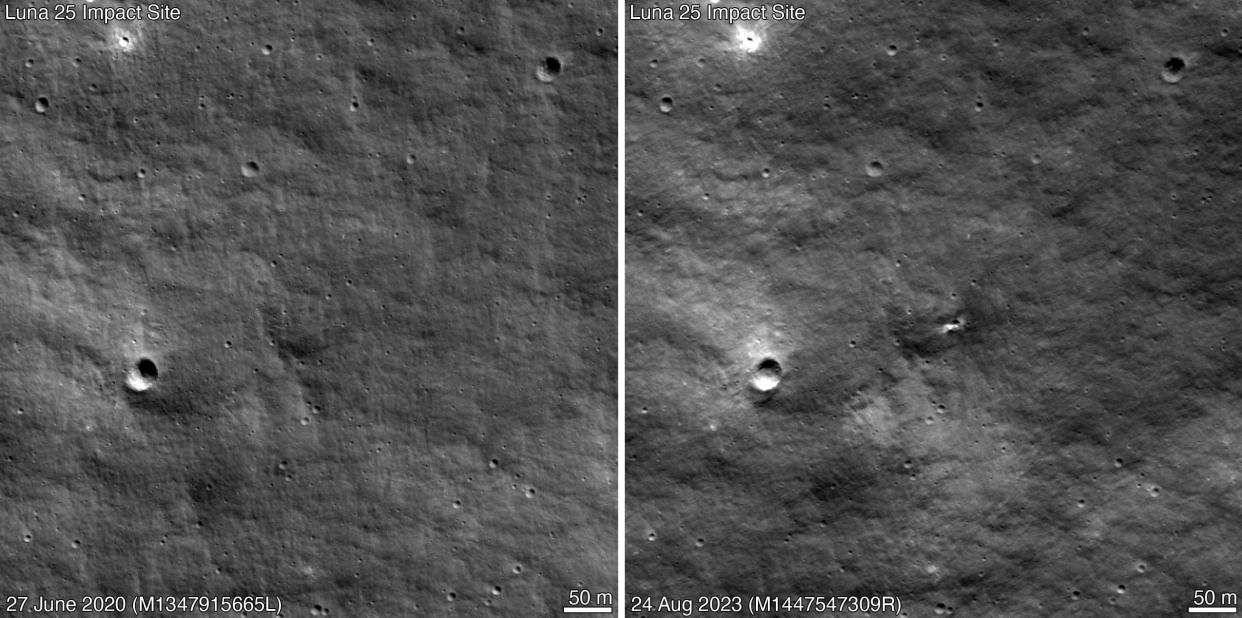NASA said its orbiter likely found the crash site of Russia's failed Luna-25 moon mission

Officials at NASA believe they have found the crash site of the Luna-25 spacecraft, Russia's failed lunar lander.
The space agency's Lunar Reconnaissance Orbiter imaged a new crater on the Moon's surface last week that had not been there before, leading NASA to conclude that the location is likely the impact site of Luna-25. The crash occurred Aug. 19 after Russia's space agency Roscosmos reported it had lost contact with the robot lander and it spun into an uncontrolled orbit.
"The apparatus moved into an unpredictable orbit and ceased to exist as a result of a collision with the surface of the moon," read a statement from the agency.
'At the threshold:' How UFOs became mainstream in America
Imaging shows appearance of new crater
NASA's Lunar Reconnaissance Orbiter mission operations team sent a signal directing the spacecraft on Aug. 22 to capture images of the site, which it did two days later on Aug. 24.
Imagery that NASA released on Thursday appears to show the appearance of a crater about 10 meters in diameter, which was not there in June 2022 during the previous imaging of the area.
"Since this new crater is close to the Luna-25 estimated impact point, the LRO team concludes it is likely to be from that mission, rather than a natural impactor," NASA said.
A race to the moon
Russia, the United States and other countries have been locked in a renewed heated space race decades after the first lunar missions first captivated the world.
Before its demise, the moon mission Russia launched this month was the nation's first since 1976, when it was still part of the Soviet Union.
The spacecraft was scheduled to land on the moon's south pole, racing to land on Earth’s satellite ahead of an Indian spacecraft. Instead, India's space program made history last week when its Chandrayaan-3 spacecraft landed in the moon’s mysterious south polar region.
The landing marked the first time any nation has landed near the south pole and the first lunar touchdown for India. India is now the fourth nation to land on the moon, following the U.S., Russia/Soviet Union, and China.
The lunar south pole is of particular interest to scientists, who believe the permanently shadowed polar craters may contain water. The frozen water in the rocks could be transformed by future explorers into air and rocket fuel.
UFO sightings: Pentagon unveils new UFO website that will be a 'one-stop' shop for declassified info
Meanwhile, the United States is preparing to send its first astronauts to the moon in a half-century as part of its Artemis missions. Three Americans and one Canadian are expected next year to board a capsule that will take them on a 10-day journey around the moon.
Then, in 2025 NASA hopes to put the first two American astronauts on the moon since the last Apollo mission in 1972. Ultimately, NASA aims to establish a permanent human presence on and around the moon as it prepares for future missions to Mars.
Contributing: The Associated Press
Eric Lagatta covers breaking and trending news for USA TODAY. Reach him at elagatta@gannett.com.
This article originally appeared on USA TODAY: Russia's Luna-25 crash site evidence found in NASA moon scan: Watch

